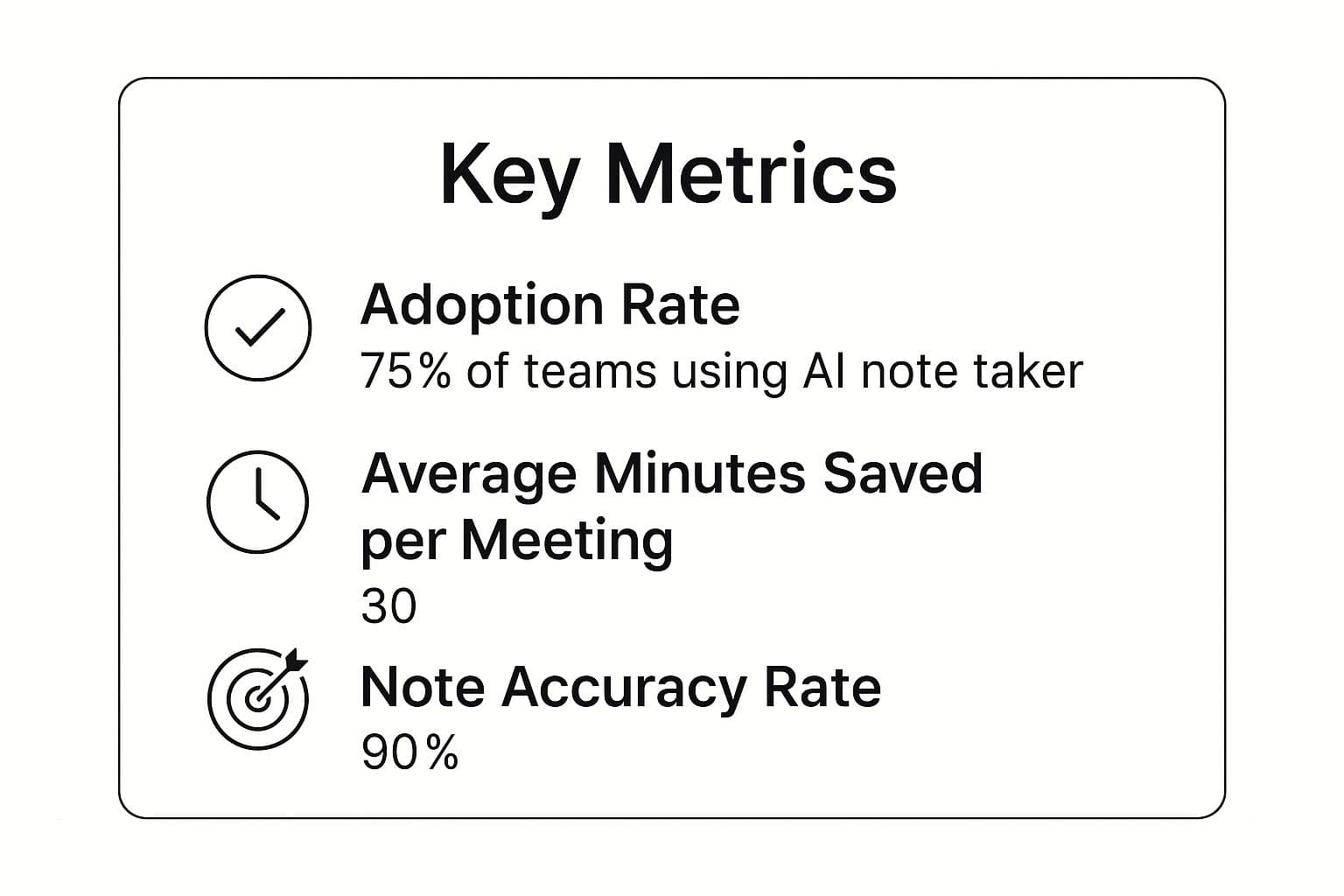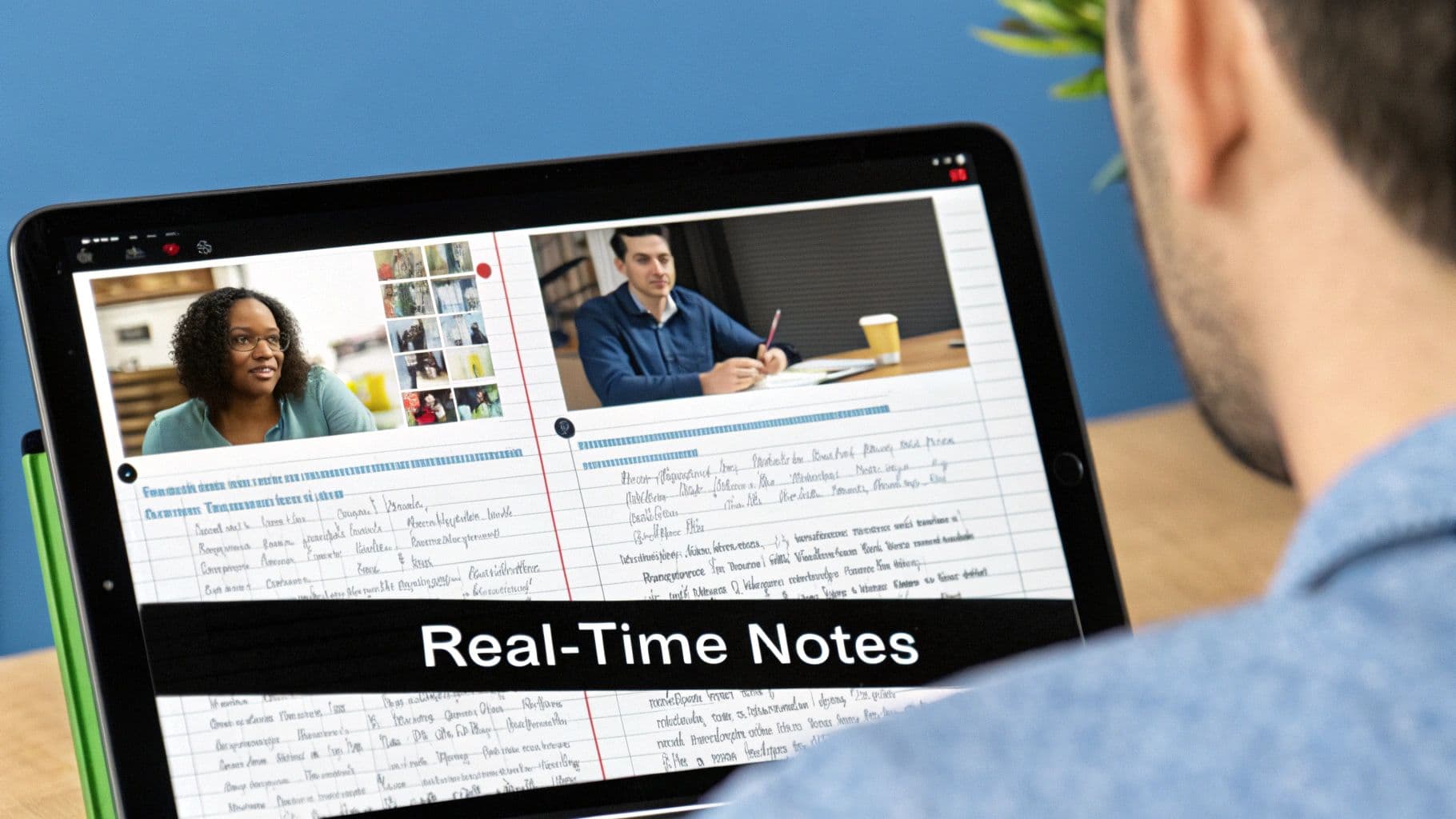An AI meeting note-taker is a smart tool that uses artificial intelligence to automatically record, transcribe, and summarize your meetings. Think of it as a personal assistant who sits in on every call, capturing every detail so you don't have to. This frees you up to actually participate in the conversation instead of frantically trying to type everything down.
Why AI Note Takers Are a Game-Changer for Productivity

In any fast-moving workplace, taking notes by hand is a serious drag on productivity. It's easy to miss important details, misremember action items, and waste hours cleaning up messy notes to share with the team. This old-school approach forces you to split your focus between contributing to the discussion and acting as the group's stenographer.
The outcome is predictable: a spotty record of the conversation and weaker collaboration. AI meeting note-takers tackle these issues head-on by creating a flawless, searchable transcript of every discussion.
The Move from Manual to Automated
Teams are catching on fast and using these tools to get their time back. The magic is in the automation—it completely removes the tedious post-meeting cleanup. Instead of spending 30 minutes trying to organize your scribbles, you get a clean, structured summary in seconds.
This simple change helps teams:
- Stay Focused: Everyone can engage fully in the conversation, knowing the details are being captured for them.
- Boost Accountability: Action items and key decisions are automatically identified and assigned, leaving no room for confusion.
- Build a Knowledge Hub: Every meeting becomes a searchable part of your company's institutional memory.
The market numbers back this up. The AI meeting assistant space was valued at USD 2.44 billion in 2024 and is expected to soar to USD 15.16 billion by 2032. Note-taking tools are leading the charge, making up 61.8% of the market revenue because they offer such a clear, immediate boost to daily work.
More Than Just a Transcript
These tools aren't just dictation machines; they actually understand the conversation. They can tell who is speaking, follow different topics as they come up, and create short, easy-to-read summaries. This is a lifesaver for anyone who had to miss a meeting or needs to quickly find a specific decision that was made weeks ago.
It's a huge leap from traditional note-taking, which is totally dependent on one person's memory and interpretation. If you want to level up from basic scribbling, our guide on https://summarizemeeting.com/blog/how-to-take-better-meeting-notes covers foundational tips that AI tools amplify. By embracing this tech, teams aren't just getting better notes—they're building a smarter, more collaborative way to work.
Comparing the Top AI Meeting Assistants
Picking the right AI meeting assistant isn't easy. The market is packed with options, but three names keep popping up for good reason: Notta, Fireflies.ai, and Otter.ai. Each one tackles the same problem—taming meeting chaos—but they do it in ways that suit very different people and teams.
There’s no "best" tool, only the best tool for you. It all comes down to your daily workflow, how your team operates, and what you really need to get out of your meetings.
A High-Level Overview of the Contenders
Let's break down what makes each of these contenders tick.
Notta really shines with its clean design and top-notch support for multiple languages. If you work with international clients or a global team, its ability to accurately transcribe 58 different languages is a massive advantage. It’s also incredibly easy to get started with.
Fireflies.ai is built for teams that live and breathe data. It's less about the basic transcript and more about what you can do with the conversation. With deep integrations and powerful analytics, it's a go-to for sales teams who want to log call notes in their CRM automatically or project managers tracking action items.
Otter.ai is one of the original players in this space, and its reputation is built on solid, reliable real-time transcription. It has a loyal following among individuals like students and journalists who just need a dependable tool to capture every word as it's spoken, without a lot of extra fuss.
The impact of tools like these isn't just a nice-to-have. The numbers show they genuinely boost how teams work.

These stats tell a clear story: people who use these tools see big jumps in efficiency, save a ton of time, and get surprisingly accurate results. It’s about working smarter, not harder.
At-a-Glance Comparison of AI Note Takers
To help you see the forest for the trees, it helps to put their core strengths side-by-side. All three are great at transcription, but their sweet spots are quite different. Ask yourself: what's my biggest headache? Is it keeping up in meetings with international colleagues? Or maybe it’s analyzing sales calls to find coaching opportunities?
This quick table cuts right to the chase, outlining who each tool is really for.
Seeing it laid out like this makes the choice clearer. A marketing team with offices in three countries will lean toward Notta’s language capabilities, while a sales team will find the Fireflies integration with Salesforce to be a game-changer.
This snapshot gives us a great starting point. Now, we're ready to dive deeper into the nitty-gritty features—like transcription quality, AI summaries, and other key functions—that truly set these tools apart. It's in those details where you'll find the perfect fit.
A Look Under the Hood: Core Transcription and AI Smarts

Let’s be honest: the real magic of any AI meeting assistant is how well it actually understands what’s being said. Marketing can promise the world, but the true test happens when you throw real-world meetings at these tools—complete with background noise, thick accents, and industry-specific jargon.
Before you can get a fancy AI-powered summary or a neat list of action items, you need a solid transcript. If the foundation is wobbly, everything built on top of it will be too. That's why we need to dig into how these platforms really perform when the pressure is on.
Transcription Accuracy in the Real World
The first hurdle for any tool is raw transcription quality. Most platforms do just fine in a perfect setting, like a quiet room with a few native speakers. But that’s not how most of us work. The best tools distinguish themselves in the messy, challenging scenarios.
Think about a global team call with colleagues from London, Tokyo, and Sydney. The mix of accents can easily trip up a less sophisticated AI. Or imagine a huddle between software engineers, where the conversation is dense with acronyms and coding terms. This is where you see what an AI is really made of.
Here’s my take on how the top contenders handle these situations:
- Otter.ai: This is a rock-solid choice for teams primarily based in North America. It delivers consistently high accuracy with standard American English and does an excellent job telling speakers apart, even when people are talking over each other.
- Notta: If you work in an international setting, Notta is a standout. Its engine has been trained on a massive variety of languages and accents, giving it a clear edge in global meetings where English might not be everyone’s first language.
- Fireflies.ai: Because it was built with sales and revenue teams in mind, Fireflies really shines when it comes to business-speak. It’s great at picking up on jargon related to CRMs, sales funnels, and project management—a huge plus for its target users.
To see why this is so critical, you can learn more about what goes into a high-quality meeting transcription in our detailed guide.
How Smart Are the AI Summaries?
After the transcript is done, the AI gets to work making sense of it all. A truly great summary doesn't just cut down the word count; it pulls out the key ideas, decisions, and action items. The quality of these summaries often determines whether a tool becomes a daily habit or just another forgotten subscription.
Otter.ai, for example, gives you a clean, chronological summary. It’s a great play-by-play of the meeting, perfect for getting up to speed quickly if you missed the call.
Fireflies.ai takes a different approach, often organizing its summaries by topic. This is incredibly useful for project managers who want to jump straight to the parts about "budget" or "deadlines" without sifting through the whole conversation. Notta pushes this even further with customizable templates, letting you decide what a "good" summary looks like for different meeting types, whether it's a one-on-one or a big client presentation.
Catching Action Items and Decisions
A meeting that doesn't lead to clear actions is just a conversation. An ai meeting note taker needs to be sharp enough to spot commitments and decisions, turning talk into tasks.
Scenario A: The Technical Deep-Dive Picture a weekly engineering sync where the team is hashing out bug fixes and new features. The language is technical and specific.
- Otter.ai will capture the words accurately, but it might not always distinguish between a casual suggestion and a firm task unless someone explicitly says, "I will do X."
- Fireflies.ai is often better at flagging these tasks, especially if you've connected it to a project management tool. It's trained to listen for phrases about deadlines and assignments.
- Notta shines here by creating a dedicated section for action items, making them easy to find and export, even if they were mentioned casually.
Scenario B: The Creative Brainstorm Now, let's switch to a marketing brainstorm. It's free-flowing, unstructured, and about capturing ideas, not assigning tasks.
In this setting, Otter.ai's clean transcript becomes a goldmine for reviewing every idea later. Fireflies’ topic tracker could helpfully group ideas into themes like "social media" or "blog posts." Notta’s summary, in turn, would be great at highlighting the most talked-about or promising concepts.
The incredible growth in this space, projected to jump from USD 2.53 billion in 2024 to USD 3.16 billion in 2025, is happening precisely because of these advancements. As a recent market analysis shows, the tools are getting smarter and more attuned to our needs. The best choice for you really comes down to which AI’s strengths match up with the kinds of meetings you have most often.
How Well Does It Play with Your Other Tools?
An AI meeting assistant is only as good as its ability to plug into your existing workflow. Let's be honest, a standalone transcript is just another document you have to manage. The real magic happens when your meeting notes automatically sync up with the tools your team already lives in every day—your CRM, your project manager, and your chat apps.
Without those connections, you're just creating more busywork. You’re manually copying and pasting action items, updating client records, and trying to remember what was said. The whole point is to eliminate that friction, letting information flow seamlessly from a conversation into a concrete action.
Connecting Your Tech Stack
When you look at integrations, don't get distracted by a long list of shiny logos. The crucial question is: what can the integration actually do? Can it just dump a transcript into a Slack channel, or can it intelligently create tasks, update records, and trigger next steps?
This is where you start to see some real differences between the big players.
- Otter.ai keeps things simple, focusing on core productivity tools. You can push transcripts to Slack to keep everyone in the loop or send recordings to Dropbox for storage. It’s straightforward and handles the basics well.
- Notta offers solid connections to essentials like Salesforce and Notion. This is a big deal for teams who need to attach meeting context directly to a client's file or a project's knowledge base. It's about keeping information organized where it belongs.
- Fireflies.ai goes all-in on deep, functional integrations, and it’s a game-changer for sales and project-driven teams. It doesn’t just record what was said; it can automatically create tasks in Asana, Trello, or Jira based on the conversation.
Just take a look at the sheer breadth of platforms Fireflies connects with. This isn't just for show; it's a clear signal that they’ve built their tool to be the central hub of your workflow.
This focus on connecting with CRMs, project management software, and everything in between is what separates a simple transcription tool from a true productivity machine.
Automation in the Real World
Okay, let's move past the feature lists and talk about what this looks like in practice. How do these integrations actually save you time and headaches?
Scenario 1: The Sales Follow-Up Imagine a sales rep just wrapped up a discovery call.
- With Fireflies.ai, the call summary, key questions from the prospect, and next steps are automatically logged in Salesforce or HubSpot under that contact. That’s 15 minutes of manual data entry saved, right there. After every single call.
Scenario 2: The Project Kickoff A project manager is running a kickoff meeting, assigning tasks left and right.
- When the manager says, "Jen, can you have the mockups ready by Friday?" Fireflies' Asana integration can catch that, create a new task, assign it to Jen, and set the due date for Friday. Otter and Notta will get the words right, but Fireflies makes it happen automatically.
These automated workflows are where you get the most bang for your buck. They chip away at the dozens of tiny, repetitive tasks that kill productivity.
If you want to see a more detailed breakdown of how different platforms connect with your favorite tools, check out our full guide on AI tool integrations. Ultimately, the best choice is the one that automates the specific, everyday tasks that slow your team down the most.
Comparing Pricing Plans and Overall Value

When you’re picking an ai meeting note taker, the sticker price is just the beginning of the story. Real value comes from matching the features to your wallet. You have to look at what you actually get for your money—things like transcription limits, AI summaries, and how well the tool plays with your other software.
A dirt-cheap plan that constantly gets in your way with tight restrictions is way more expensive in the long run than one that costs a bit more but just works. Let’s break down how these tools stack up, whether you're flying solo, running a small team, or outfitting a whole enterprise.
Unpacking the Free Tiers
Free plans are the ultimate "try before you buy," but they all have guardrails designed to get you to upgrade. Knowing what those are ahead of time saves a lot of headaches.
Otter.ai has historically been the go-to for its generous free plan, making it a favorite for students, journalists, or consultants with occasional meetings. You get enough transcription minutes to really get a sense of what the tool can do for you.
Fireflies.ai and Notta also let you in the door for free, but they tend to gate their best stuff, like advanced integrations or custom dictionaries. Think of their free tiers as a test drive for transcription quality and the overall user experience before you put any money down.
Finding the Sweet Spot for Small Teams
Once you pull out your credit card, the game changes. For a growing team of 5 to 20 people, you're looking for that perfect blend of collaborative features and a reasonable price tag. This is where the "Pro" or "Business" plans shine.
Fireflies really comes alive in this category. Its mid-tier plans are where you unlock the powerful CRM and project management integrations that make it so compelling. For a sales team of 15, automatically pushing call notes into Salesforce is an ROI no-brainer that makes the per-seat cost an easy decision.
Notta's appeal for small teams is its one-two punch of high accuracy and great collaboration tools, like shared team workspaces. If your team is global, its fantastic multilingual support at this price point can be the deciding factor. Otter.ai remains the reliable workhorse, with top-notch transcription and speaker ID for teams who just need a crystal-clear record of every conversation.
Cost and Feature Comparison Across Tiers
To make sense of the different price points, it helps to see what you get—and what you don't get—with each plan. This table breaks down the typical offerings from the free plans up to the enterprise level.
Ultimately, the best value tier is the one that removes friction from your team's specific workflow without charging you for enterprise features you'll never touch.
Enterprise-Grade Features and Security
For big companies, the conversation shifts to security, scalability, and control. This is where the "Enterprise" plans from all three platforms become non-negotiable.
These top-tier plans offer the features large organizations demand, including:
- Single Sign-On (SSO) for easy and secure access.